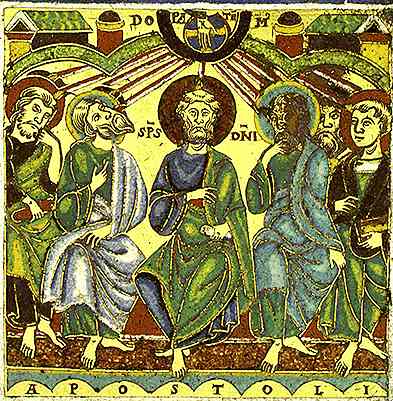Pentecost

Meuse Valley, circa 1150-1175
Champlevé enamel on copper gilt; 4 1/16 x 4 1/16 in. (10.3 x 10.3 cm.)
The Cloisters, New York City, 65.105
St. Peter sits between four other apostles. Another can be seen past the shoulders of the two on the right. The beardless young man on the far right is most likely St. John the Evangelist.
The image suggests two significant theological points. The first is that the entire Trinity is involved in this event. The Father is represented by the hand in the outer circle and by the word pate[r], the Son by the cross in the smaller circle, and the Holy Spirit by the rays reaching down to the Apostles and by the letters to the left and right of Peter's head, which abbreviate the words spiritus domini, "the Spirit of the Lord."
Second, St. Peter's leadership of the new church is emphasized by his position directly below the hand, where Christ is pictured in many Transfiguration and Baptism of Christ images. There is even a suggestion of his consecration into the priesthood in the "tonsure" forming just where the ray touches his head.
Many later images have the Apostles standing with the Virgin Mary. In the account in Acts 2:1-3 they are seated and Mary is not mentioned, but later works will take their cue from Acts 1:14, which says she was with them in "the upper room" on the day Matthias was chosen to replace Judas.
Acts 2:1-2 says the Apostles were in the same upper room in a domus (house) for the two events. Accordingly the space they occupy is labeled by the letters DO and Mꝰ, for domus. The fact that they are in an upper room is expressed by the tops of towers and buildings in the background, and the three green arcs above the men's heads represent the roof.
Read more about images of Pentecost.
Photo: Metropolitan Museum of Art